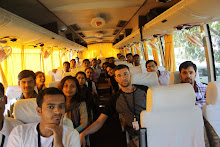Prasanna Thakur:
In west Bengal & Orisa in addition to Chattisgadh are being highly affected by maoist activities. Recently Lalgadh in West Bengal and Koraput in Orisa are in the limelight continuously for Maoist problem. Maoists killed indiscriminately villagers and the policemen at both places.
Lalgadh and Koraput are strongholds of Maoists. Home Minster P. Chidambaram visited Lalgadh, perhaps for the first time mingled with the villagers and listen to them and offered condolence. He remarked that the state government has to do much more to eliminate Maoists.
P. Chidambaram indicated that he is not satisfied with west Bengal govt. At the same time when home minister was on Lalgadh visit, Maoists killed 10 policemen in Orisa . The act shows that Maoists are not deterred by the measures taken up by govt. This situation puts a big question mark on the security and development of Maoists affected areas.
Monday, April 5, 2010
Subscribe to:
Post Comments (Atom)

मुद्दा काय आहे, समजला नाही...
ReplyDeleteMala pan, mala pan, mala pann
ReplyDeleteMala suddha
Malaa hee samajlaa nahee.
:(
*drowns himself*
well in Afghanistan ordinary people have no security . those news man who going in between two group who already involve in battle , how you grantee a safe time for them . news man should use new new technique for collecting news from different part of country . same time should be buy the new . same should be use he is local agent and same time share he is news with those who already was in area . i means war new man or crime branch news man have not grantee from any one in even peace full country . in Afghanistan once you walk out of government territory then you on your own .
ReplyDeletemohammad nasir
This is not surprising. The freedom of expression is deprived because of the corrupt and warlord government. The Journalist could not report since the government is afraid that their warlords and corruption will be exposed. However, the Government should know that everyone knows that the government is inefficient, corrupt and warlord are ruling and silence of journalist cannot hide the factthis kind of people who have no knowledge and experience of talk to people of society that all are bound by Islamic radiology generation by generation have to be punished . first because theses are put in problem a thousand other life and situation in jeopardy of an idiotic government . now this guy are free by order of karazi to win election . nix time never this going to happen .
ReplyDeletefarid ahmad monib
"Censorship in Afghanistan" includes the following nine chapters:
ReplyDeleteChapter 1 focuses on the long, sad history of crimes against humanity and human rights abuse in Afghanistan of which censorship and illiteracy has been a centerpiece.
Chapter 2 introduces the general topic of censorship and specifically what occurs in Afghanistan. It discusses the enormous amounts of money that governments and NGOS have poured into Afghanistan to support a free media. Consultants have been paid huge sums of money to do this, but the net result over the past nine years is a situation that is nearly as bad under the Taliban.
Chapter 3 discusses who carries out the censorship, including Afghan security forces, the Taliban, the Ministry of Culture, various governors, warlords, commanders, and those involved in the massive drug trade. Add to that list, international troops, the Attorney General, Interior Ministry, Education Ministry, Finance Ministry, Parliament and other governmental institutions.
Chapter 4 discusses the phenomenon self-censorship for self-preservation, involving security, political and economic considerations, and social and cultural elements that must be considered by persons contemplating speaking out.
Chapter 5 catalogs the names and circumstances of journalists killed in Afghanistan since 2001. It includes both Afghan and foreign journalists. Additionally, it includes a list of journalists who fled Afghanistan after threats and attacks due to their work, and a calendar of both fatal and non-fatal attacks from 2001 to 2009.
Chapter 6 reviews the development of mass media in Afghanistan, after the fall of Taliban, including radio, TV, print, news agencies, independent journalists, the Internet, the mass media audience, and the quality of journalistic efforts.
Chapter 7 concerns journalists and other individuals and organizations dedicated to defending freedom of information in Afghanistan. They include the Committee to Protect Journalists, the International Federation of Journalists, the United Nations, the International Freedom of Expression eXchange, and Reporters Without Borders, which globally publicize attacks on journalists and free speech in Afghanistan.
Chapter 8 presents an overview of Afghan media law, and its various permutations including the creation of the government news agency Bhaktar, a history of various media laws going back fifty years, military censorship, Taliban media laws, and current trends in media law enabling legal censorship by the Afghan government.
Chapter 9 discusses possible solutions to opening up Afghanistan’s closed media world. They include programs to eliminate illiteracy, the transitional justice project espoused by former Finance Minister and 3rd place 2009 presidential candidate Dr. Ramazan Bashardost. It also provides a list of additional resources and sources used. Additional attachments include the latest media laws in Afghanistan enacted last year by its Parliament and copies of original government documents that encourage and promote official censorship.
“Censorship in Afghanistan” is a remarkable book that could spur needed change in Afghanistan. Afghans have suffered long and hard under the control of corrupt governments, war lords, drug lords, and religious autocrats. It is knowledge like this that will help set them free. It is particularly sad that the leading global news media and writers have been so silent on this topic for so long.
Ramkishan here. I think its a big question aani tyachyawar solution shodhan khup mahatwac aahe. Fakt ek samasya mhanun nahi tar kahitari changl nirman whaw ya hetun kam karne garjeche aahe. Tya lokac punarwasn garjec aahe.
ReplyDeletehowdy, your websites are really good. I appreciate your work.
ReplyDeletewww.rafeeg.ae